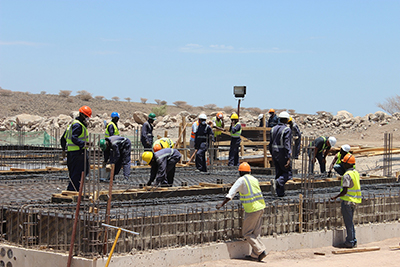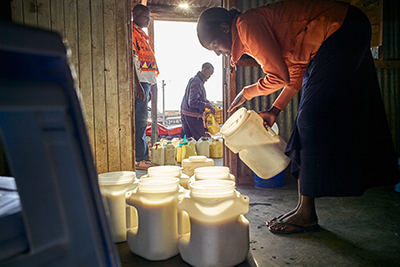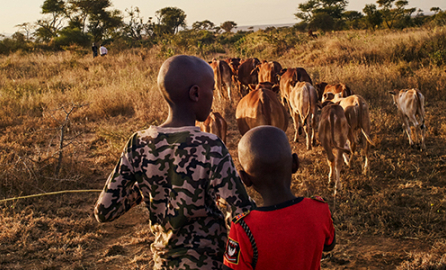The EU spends about €100 million on development cooperation in Kenya each year, focusing on resilience to climate change, infrastructure and governance. EU Head of Cooperation Erik Habers discusses capacity-building for drought resistance, financing a new wind farm through blending, and the value of evaluations.
| Erik Habers was appointed Head of Cooperation at the EU Delegation to Kenya in 2013 after having served for four years as Head of Cooperation at the EU Delegation to Indonesia and ASEAN. Mr. Habers has worked in South East Asia covering Thailand, Laos, Cambodia and Myanmar and has held various posts at the EU HQ in Brussels. |
Capacity4dev (C4D): What are the main sectors and goals of EU cooperation in Kenya?
Erik Habers (EH): In Kenya we have three sectors of cooperation: infrastructure, which comprises energy and transport infrastructure; agriculture, which includes resilience in the drier areas of Kenya; and governance, where we focus on devolution as well as justice.
The government is relatively stable, with a relatively stable budget. Yet there is still a lot of poverty and inequality in the country, so one of the agenda points which I think will remain for some time is how to rebalance the inequality.
One of the good things in Kenya is the devolution of power to the counties, which was introduced in the 2010 Constitution. It’s been a game-changer: it has brought a lot of power and also finances to the more remote regions. Before, financing activities and providing services like health care and education in remote areas was really an issue. Now with the devolution of power, the counties have the tools to really make a difference in more difficult areas, which of course is very good for poverty alleviation.
So our role in the long run will probably be decreasing actual finances, but trying to keep up the pressure on certain policies. What we’ve seen around the world is that very often when economies grow, inequality also grows. So we’ll have to keep pushing for the government to put policies in place to counter that.
C4D: Could you outline how the Delegation works at county and regional levels?
C4D: Development partners are increasingly interested in leveraging their aid, using it as a catalyst to bring in private financing for development. What’s been your experience of blending in Kenya?
EH: A very exciting project which is almost finished is the Lake Turkana wind farm, which is a blending project combining grants with loans and which involves a lot of European partners, both on the financial side as well as on the technology side. It uses European technology – we have Vestas, the Danish wind turbine company, providing the turbines, and it’s exciting because it’s a massive wind park and there aren’t that many in Africa. It’s in a very remote area [Loiyangalani District, Marsabit County] in the northwest of the country, so it has a kind of rural development dimension.

It’s not something you design overnight – 365 wind turbines is a massive undertaking. This programme was designed over a period of at least ten years, and of course the local community were consulted from early on, as well as the local government and central government. There’s a lot of infrastructure being built around it for the local community, including to supply water. And a power purchasing agreement had to be done with the electricity companies, as the wind farm will provide low cost energy to the national grid.
The whole project is about €600 million, and the contribution from the EU side is a grant of €25 million. There are EU banks including from Germany, Denmark, the Netherlands and Finland as well as African partners; private arms of investment banks but also public and development banks. The European Investment Bank has a loan of almost €250 million, so it’s a major financial partner alongside the African Development Bank. This was one of our first blending experiences in Kenya, and we’re working on many others at the moment. I think this is specifically a very catchy project which basically ticks all the boxes.
C4D: If another country wanted to embark on a similar project, what would be your advice?
EH: If you look at blending projects, most of them are very specific to a particular sector or a region, so there isn’t a magic concept which always works; and especially if you work with private operators the conditions are very different from country to country.
I think the trick is to keep very close relations with the investment banks and development banks and know very early on what they are planning to do, where they see their investment going, and try to see whether we can bring some of them together.
We’re working on an exciting new project for mass transport in Nairobi now - there’s hardly any public transport, so again we’re trying to bring together different banks. As the EU Delegation you can play a catalyzing role because not all the banks would have known about this, and so we’re trying to bring them together and try to encourage them to make loans available now.
C4D: How do you assess the impact of your programmes? What role do mid-term and final evaluations play?
EH: Evaluations are an absolutely crucial part of the overall management of the portfolio. Programmes can last four, five, six years or longer, so it’s actually quite normal to realign or reorient the program halfway through, and mid-term evaluations can give you that perspective. Of course we have monitoring as well, but evaluation allows us to go a bit more in depth and bring out any anomalies or restructuring suggestions which then can be taken on board. It feeds into all the beneficiaries, the government, the implementing partners.

Final evaluations are useful because they can really bring out results, which is useful since these days we’re all focused on how to communicate on results, what we achieve with all this money spent.
If you’re lucky you can immediately apply the outcome of an evaluation, say if there’s a next phase of the programme you can easily link it. But in my experience those cases are relatively minor, because it doesn’t happen too often that you have a set-up which is then being extended into something similar. And the link and the sharing of information on similar sectors between Headquarters and Delegation is not that strong. We could do a lot more to try to connect people working on similar files and working on similar programmes to share this information.
C4D: What’s been your experience of Joint Programming with the EU Member States? And how is it seen by the government?
EH: Jointly as EU partners (European Commission plus nine Member States) we’ve made available €3 billion covering the second medium-term plan of the government, 2014-17. We have a division of labour, so for example we are not involved in health care or education, but some of the Members States are, and we encourage them to get together. I wouldn’t say it’s happening at light speed, but the family is definitely getting closer together on the ground.
There is a lot of buy-in from the government for working jointly, though Kenya still prefers from a foreign policy perspective to keep relations with all the countries individually. Of course, the more political our development work is getting, the more closely you link to the foreign policy elements. I think the buy-in is more from the line ministries, whereas if you go to the Ministry of Foreign Affairs there’s a bit more reluctance to really embrace this idea that we work with Europe as one, because in terms of political relations they want to keep relations with individual countries very much open.
C4D: Kenya suffers frequent droughts which can be disastrous for pastoral communities. How is the EU supporting a long term (rather than reactive) response?
EH: In the past, nothing happened until there was a drought, and then suddenly the whole international community was coming in, and we’d have to do whatever was needed in those circumstances.
So together with some other development partners we have tried to build up capacity inside the government to handle this kind of crisis. For the last seven or eight years they’ve built up a National Drought Management Authority. On one hand it monitors the situation, the signs that we’re going into a period of drought, like rainfall and cover of grass and bushes, and tries to bring out early warnings. Policy-makers can then take preventive measures.

The other side is providing finances to intervene in case of need, so rather than us running in as development partners, you have as a first responder the government, which is what we have in Europe of course. One of the measures which is typically happening is the de-stocking of livestock. If animals die in the dry period there’s nothing anymore; so rather than wait for the drought to hit, you buy the livestock from people - you give them the funds, so rather than having to take care of the animals they have the money; and once you’re through the dry period they can rebuy livestock and carry on.
It’s done through the government at county level. They basically go into remote areas and buy livestock; it’s then slaughtered for meat, for food. People are well-connected, so they know very quickly if livestock destocking is happening. Mobile networks are widespread in Kenya; normally the first thing people have even if they’re in faraway regions is a mobile phone. And mobile banking is very advanced in Kenya, which has been tremendous for development purposes.
It works well in Kenya; you need a functioning government to implement these kinds of programmes, and one which is relatively advanced because it involves quite a bit of technology analysis and financial management.
Image credits: European Commission / Andrew Renneisen; Turkana wind farm: George Garang via Creative Commons license 2.0

Log in with your EU Login account to post or comment on the platform.